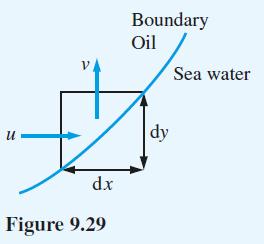(a) An oil tanker runs aground on a reef and its tanks rupture. Assuming that the oil...
Question:
(a) An oil tanker runs aground on a reef and its tanks rupture. Assuming that the oil forms a layer of uniform thickness on the sea and that the rate of spill is constant, show that the rate at which the radius r of the outer boundary of the oil spill increases in still water is proportional to 1/r.
(b) The spillage takes place in a current flowing north with constant speed V. Assuming that the velocity of the oil with the current is the vector sum of the velocity of the oil in still water and the velocity of the current, show that the velocity (u, v) of the oil at the point (x, y) relative to the stricken tanker is given by

where k is a constant of proportionality and the x and y axes are drawn in the easterly and northerly directions (see Figure 9.29).

(c) Deduce that the most southerly point (0, –c) reached by the oil slick is given by c = k/V.
(d) Show that, after a large interval of time, the oil slick occupies a region whose boundary y = f(x) is the solution of the differential equation

that also satisfies the condition y = –c at x = 0.
(e) Use the substitution y = xz to transform the differential equation and initial conditions of part (d) to the differential equation

(f) Show that the solution of (9.59) together with the boundary condition is z = −cot x/c . Hence find y and sketch its graph.
Step by Step Answer:






